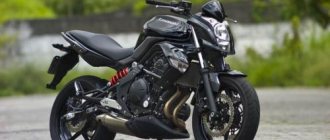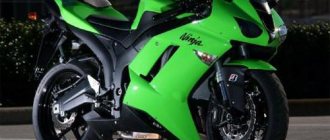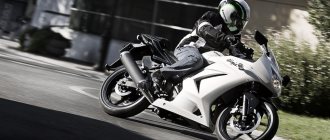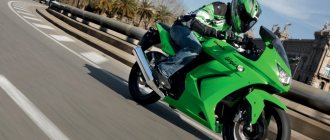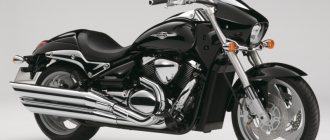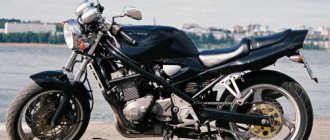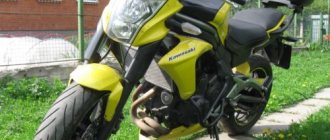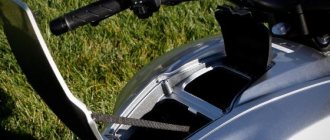Sportbike Kawasaki Ninja ZX-6R 2021
This latest mid-sized Ninja sportbike from Kawasaki with an engine displacement of 636 cubic meters has received a number of improvements, including a new hood design, LED lighting technology and a new dashboard. The electronic components have also been updated, thanks to which the device received switchable engine traction modes, traction control, and, on the model with ABS, the proprietary IBS (intelligent braking system). Want to know more? Read on.
Kawasaki Ninja ZX-6R 2019
2021 Kawasaki Ninja ZX-6R Review
Over the past few years, prices for mid-sized sportbikes, like smartphones, have been steadily rising. But Kawasaki took a different route. It updated its Ninja ZX-6R supersport, added electronic aids for riders who want to leave tire marks on public roads or on the track, and lowered its final price ($9,999).
Kawasaki decided not to reinvent the wheel and kept the road-focused 636cc inline-four engine introduced back in 2013. Thanks to this engine, the ZX-6R feels great both on city streets and on the track, unlike some competitors.
Kawasaki hopes to bring the Ninja ZX-6R back into the spotlight with a series of upgrades and cost reductions
This engine has been tuned to deliver smooth power over a wider range with better torque distribution. Yes, the best responsiveness is still at high speeds, but the engine has become less sensitive to gear position. Therefore, the ZX-6R has a certain degree of flexibility, for example when exiting a corner, because the engine does not always need to be revved high to show off its muscles. You can rev the engine to redline or upshift close to the limiter, but you'll still be able to enjoy the broad torque curve of the midsize inline-four.
Kawasaki updated the Ninja ZX-6R for the public road, but it's still a capable track bike.
The electronic quickshifter increases the pleasure of riding the motorcycle, as it allows you to shift up the gears of the 6-speed gearbox without closing the throttle. The 15-tooth drive sprocket reduces the final drive ratio and increases acceleration. However, in top gear, at a speed of 100 km/h, the tachometer needle points to 6000 rpm. The shorter final gear certainly helps with acceleration, especially in the first three gears, but the quickshifter could be faster as there is still a noticeable pause between shifts. A quickshifter is certainly better than a manual shifter, but some aftermarket quickshifters are much faster.
636 cc inline four-cylinder engine. has a wide power range
When using a motorcycle on a track, where you often have to “click” gears, you would like to have a two-way quickshifter on board, but you will have to be content with what you have. It is worth noting that the transmission shifts smoothly from one gear to another with clear and easy clutch operation. The position of the clutch lever, like the brake lever, is adjustable, although there have never been any particular problems with working with non-adjustable levers.
The updated dashboard has a fuel gauge and an ECO indicator, which help monitor the fuel level in the 17-liter tank. The tachometer needle acts as a blinker, helping the pilot choose the right moment to change gear. The timing of the blinker can be adjusted in steps of 250 rpm.
The dashboard has been completely updated. The tachometer needle acts as a blinker
Among other things, the motorcycle is equipped with three-mode traction control and 2 power modes. This allows experienced riders to exploit the bike's full potential, while novice riders can use the Low Power mode to better get to know the character of the new ZX-6R. When testing the motorcycle on public roads, careful use did not trigger the traction control, but it is still nice to know that it is there.
Curb weight of the Kawasaki Ninja ZX-6R is only 196 kg
The new ZX-6R features new fairings reminiscent of its smaller brother, the Ninja 400. The dual LED headlights and other touches, including a new muffler, will certainly be praised, but it's a shame that the bike looks half the price it actually costs. It's nice to see the family touches of the Kawasaki lineup, but I wish KHI would give the ZX-6R a more unique and aggressive look.
Three-mode traction control (plus OFF) allows you to do wheelies in the least intrusive mode 1
Weighing in at 196kg, the ZX-6R is a lightweight bike with excellent weight distribution. This nimble motorcycle goes exactly where you want it to go. The newly developed Bridgestone Battlax S22 tire performs noticeably better on public roads than the S21, which already had exemplary performance.
The front fairing is distinctly reminiscent of the Ninja 400's little brother. The LED headlights are a major upgrade
The ZX-6R's suspension is more efficient than most other sport bikes. The suspension's smoothness is clearly noticeable on public roads, which is one of its best features. Both the front fork and rear shock have damping adjustments, but at high track paces this didn't add much benefit.
An electronic quickshifter is standard on the Ninja ZX-6R. It allows you to change gears up without closing the throttle
The Ninja rides like a Cadillac, cruising smoothly around the track with a high level of control and stability. Changing the suspension damping level made the bike more controllable, but unfortunately had no effect on lap times.
The Ninja ZX-6R's suspension is more street-oriented than track-oriented, but still amazingly tuned, especially for a sportbike.
During the test part on the track, instead of S22 (on which you can freely spend the entire track day), the motorcycle was “changed” to Bridgestone Battlax R11 tires. These tires are an evolution of the previous design with a simplified compound that operates over a wider temperature range. The tires turned out to be flawless and showed excellent stability and grip on the road surface. Most of the session was spent with the traction control system turned off, as the combination of these tires and engine power already provided maximum traction.
The Ninja ZX-6R's standard Bridgestone Battlax S22 tires perform well in both wet and dry conditions.
Mid-sized sports bikes are losing their popularity year after year, but it's important to remember that Kawasaki has been building its motorcycle masterpieces for 35 years. That's why Kawasaki remains committed to the segment, striking a delicate balance between performance, style and value.
Design
Kawasaki has updated the appearance of the sportbike, and the first thing that catches your eye is the front fender cutouts, which, apparently, are only needed to reduce unsprung weight on the front axle. The twin LED headlights are still located directly below the central air intake, but are lower and flatter, fitting into the new model's angular appearance, which contrasts with the more handsome previous generation. The angularity of the design affects the entire vehicle as a whole, but this is especially noticeable in the front and side hood, as well as in the subframe panels just below the edge of the passenger seat.
At the rear, the license plate increases the working area of the compact mudguard. The rear turn signals and license plate lights are mounted just below the new LED tail light integrated into the tail. The 17-litre tank looks the same as the previous version, widening towards the steering column and tapering towards the seat to cover the knees when hanging down and other weight transfers.
Due to the fact that both the tank and the body of the sportbike in the seat area, and the seat itself at a height of 83 cm, are very narrow, it is convenient to sit on the motorcycle in a compact position and ride slowly with your feet lowered from the pegs. New mirrors on the front fairing are mounted on the sides of a low windshield. Behind the windshield is an updated instrument panel with a single dial instrument - a tachometer, and the rest of the information is displayed on the LCD screen.
The seating position remains the same: short clip-ons, rear-mounted footpegs with gearbox feet and brakes place the rider in a sporty, reclining position on the tank, with the legs high, away from the asphalt. For the convenience of riders of different heights and builds, the manufacturer has equipped the bike with adjustable clutch and front brake levers with five positions.
Kawasaki Ninja ZX-6R 2019
Kawasaki Ninja ZX-6R chassis
A stamped aluminum perimeter frame with a two-piece cast subframe and an impressive swingarm form the supporting structure of this beast. Symmetrical 17-inch alloy wheels are shod on the Battlax Hypersport S22 - 120/70 at the front and even wider 180/55 at the rear.
Mounted to the massive swingarm is a Uni-Trak monoshock with infinitely variable compression damping, 25-step rebound damping, and, of course, spring preload adjustment. The Showa SFF-BP 41 inverted fork also has a full set of settings, which means the rider has full control over the nature of the suspension.
Kawasaki Ninja ZX-6R 2019
The suspension with 119 mm of travel at the front and 135 mm at the rear is sufficient for driving on asphalt and works well even in the most difficult turns. The frame and fork design improves the bike's stability when slowing down and collapsing the suspension.
A pair of four-piston Nissin calipers on two 310 discs make up the front braking system, while the rear consists of a single-piston caliper on a 210 disc. The 636th Kawasaki Ninja ZX-6R is also available with ABS on both wheels.
Kawasaki Ninja ZX-6R 2019
Kawasaki Ninja ZX 6R design
Kawasaki designed the Ninja ZX 6R to be a serious midsize sports machine, not just another pocket lighter. Therefore, it starts with a fairing very similar to the “face” of its older brother, the ZX-10R. The fairing has a low drag coefficient, and the low windshield forms an air pocket for a sporty landing, which is also favored by short clip-ons located flush with the upper crossbar.
Twin headlight "eyes" are recessed slightly into the fairing, and the front turn signals are integrated into the edges of the side panels in an attempt to reduce drag to a minimum. An air duct located in the center of the fairing provides direct air flow, and thanks to the ramming effect, the efficiency of air intake is significantly higher than that of engines with a conventional “breathing” system, with a corresponding increase in power. And of course, installing the radiator inside the capsule formed by the side panels and the front fairing allows you to effectively remove heat from it, removing warm air behind the body panels.
The 17-liter tank defines the top contours of the bike, tapering downwards to form a knee-hugging pocket. The tail is upturned in contrast to the low nose that is typical of modern supersports, and although the tail section has a passenger seat and a pair of folding footpegs attached to the subframe, the rear design is more about aerodynamics than passenger comfort.
The design of the mudguard is quite controversial; perhaps a regular wing-hugger would be a better solution. Well, families of customizers need to eat something...
Engine Kawasaki Ninja ZX-6R
The heart of the Kawasaki Ninja ZX-6R sports bike is an in-line four-cylinder liquid-cooled engine, which also dampens some of the noise thanks to the engine’s water jacket. Two overhead camshafts control the timing of the 16 valves, while a set of 60-micron injector nozzles and 38-mm Keihin throttle valves ensure the finest atomization of the fuel mixture and its optimal combustion.
67 mm cylinders with a piston stroke of 45.1 mm create a working volume of 636 cubic centimeters. The compression ratio, as befits a highly accelerated sports engine, is high - 12.9:1. Yes, it requires top-end fuel, but in return it produces top-end power - 110 hp.
Kawasaki Ninja ZX-6R 2019
The entire design is designed to produce high power - including the variable length intake and 5.09-liter airbox - and thanks to modern technology, the engine produces significant torque - 70.6 Nm at 11,500 rpm. It's clear that this sports engine has a torquey character, with the new ECU tuning squeezing the exhaust into Euro4 limits. Power is transferred through a light-throw slipper clutch and a six-speed gearbox, and then via a sealed chain to the rear wheel.
The traction control system monitors the rotation speed of both wheels and, if a difference is detected, reduces engine traction. Traction control has three levels of sensitivity, plus the device has traction modes - “Full” and “Reduced”, in case of bad road conditions. Kawasaki also added a quickshifter to the Ninja ZX-6R sportbike, or rather half a quickshifter, since it only works when shifting up.
Engine Kawasaki ZX 6R
The protagonist of today's play is Kawasaki's compact 636cc four-cylinder engine. cm , definitely short-stroke, with a piston diameter of 67 mm and a stroke of 45.1 mm. The pistons have shortened skirts to reduce moving masses and increase available rpm. The compression ratio is high - 12.9:1.
A quartet of 38mm Keihin throttle bodies provide this monster with air. The engine has a number of electronic features including power modes and traction control. Power modes allow you to select engine power - full, or 80% of full with a softer response to the throttle, and a three-stage traction control system intervenes in the timing and ignition when it detects wheel slip. In other words, the set of road functions here is excellent, but for the track there is not enough launch control and quickshifter, at least in the stock version.
The clutch of the Kawasaki ZX 6R is slippery and has a lightweight release , so it is not only easy to press, but also allows you not to tear off the wheel with the braking torque during a sharp downshift. The cassette transmission brings the motorcycle closer to modern racing supersports, as does the competent weight distribution: the center of mass of the motorcycle is low and as central as possible.
How does he drive? The manufacturer claims 70.6 Nm at 11,500 rpm, so there is a lot to squeeze out here, but you need to spin it properly first.
